Decarbonization Prospects in the Commonwealth of Independent States
Abstract
:1. Introduction
2. Materials and Methods
3. Results and Discussion
3.1. Exiting Trends in the CIS Based on Statistical Data and Policy Analysis
3.2. Scenario-Based Decarbonization Forecasts
4. Conclusions
Author Contributions
Funding
Institutional Review Board Statement
Informed Consent Statement
Data Availability Statement
Acknowledgments
Conflicts of Interest
References
- Hartwell, C.A. A Eurasian (or a Soviet) Union? Consequences of further economic integration in the Commonwealth of Independent States. Bus. Horiz. 2013, 56, 411–420. [Google Scholar] [CrossRef]
- Interstate Statistical Committee of the Commonwealth of Independent States. Socio-Economic Situation of the Countries of the Commonwealth of Independent States. Available online: http://www.cisstat.org/eng/frame_public.htm (accessed on 21 January 2022). (In Russian).
- Belta Information Agency, CIS Countries Have Discussed the Input of Electric Power Industry in Decreasing Greenhouse Gas Emissions. 28 December 2021. Available online: https://www.belta.by/society/view/strany-sng-obsudili-vklad-elektroenergetiki-v-snizhenie-vybrosov-parnikovyh-gazov-477088-2021/ (accessed on 21 February 2022). (In Russian).
- UNDP. Turkmenistan’s National Climate Change Strategy—June 2012. Available online: https://www.adaptation-undp.org/resources/naps-non-least-developed-countries-non-ldcs/turkmenistans-national-climate-change-strategy (accessed on 4 February 2022).
- Lobova, S.V.; Ragulina, J.V.; Bogoviz, A.V.; Alexeev, A.N. Energy security performance: A dataset on the member countries of the Commonwealth of Independent States, 2000–2014. Data Brief 2019, 26, 104450. [Google Scholar] [CrossRef]
- Adedoyin, F.; Abubakar, I.; Bekun, F.V.; Sarkodie, S.A. Generation of energy and environmental-economic growth consequences: Is there any difference across transition economies? Energy Rep. 2020, 6, 1418–1427. [Google Scholar] [CrossRef]
- Brucker, B.; Hubacek, K.; Shan, Y.; Zhong, H.; Feng, K. Impacts of poverty alleviation on national and global carbon emissions. Nat. Sustain. 2022. [CrossRef]
- Bolea, L.; Duarte, R.; Sánchez-Chóliz, J. Exploring carbon emissions and international inequality in a globalized world: A multiregional-multisectoral perspective. Resour. Conserv. Recycl. 2020, 152, 104516. [Google Scholar] [CrossRef]
- CAN EECA. Analysis of Climate Policies in Eastern Europe, Caucasus, and Central Asia Countries 2020. Climate Action Network Eastern Europe and Central Asia. Available online: https://infoclimate.org/?books=analiz-klimaticheskoj-politiki-stran-vostochnoj-evropy-kavkaza-i-czentralnoj-azii (accessed on 3 February 2022). (In Russian).
- FAO. Regional Synthesis on the Forest Genetic Resources of Central Asia. 2013. Available online: https://www.fao.org/family-farming/detail/en/c/296630/ (accessed on 3 February 2022).
- Apergis, N.; Payne, J.E. The emissions, energy consumption, and growth nexus: Evidence from the commonwealth of independent states. Energy Policy 2010, 38, 650–655. [Google Scholar] [CrossRef]
- Apergis, N.; Payne, J.E. Energy consumption and economic growth: Evidence from the Commonwealth of Independent States. Energy Econ. 2009, 31, 641–647. [Google Scholar] [CrossRef]
- Matveev, U.L.; Nikolaeva, E.U. The Influence of Antropogenic Factors on the Climate in the Northern Hemisphere. Bull. Polar Acad. 2012, 1, 62–70. Available online: https://elibrary.ru/item.asp?id=22532460 (accessed on 21 February 2022).
- Bykovsky, V. International Legal Regulation of Combatting Global Warming and the Approaches of Russia and CIS Countries to Ratify the 2015 Paris Agreement on Climate Changes. Int. Coop. Eurasian States Policy Econ. Law 2017, 1, 100–108. Available online: https://elibrary.ru/item.asp?id=29810090 (accessed on 21 January 2022).
- Kovalenko, V.V.; Khaustov, V.A. Criteria of Stable Development of Hydrological Processes and Mapping of Zones of Expected Anomalities in the Annual River Runoff Parameters in the CIS Countries at the Antropogenic Climate Change. Russ. Meteorol. Hydrol. 1998, 66–71. Available online: https://elibrary.ru/item.asp?id=30130052 (accessed on 21 January 2022).
- Moreva, E.L. The Crisis and the Policy of Environmental Integration in the EU and CIS. Curr. Probellms Eur. 2014, 1, 77–111. Available online: https://elibrary.ru/item.asp?id=21289999 (accessed on 21 January 2022).
- Malik, L.K. The Likely Imact of Global Warming on Water Resources and Energy Facilities. Hydraul. Constr. 2005, 5, 1–14. Available online: https://elibrary.ru/item.asp?id=9150020 (accessed on 21 January 2022).
- UNFCC. Paris Agreement, United Nations. 2015. Available online: https://unfccc.int/sites/default/files/english_paris_agreement.pdf (accessed on 18 January 2022).
- Apeaning, R.W. Technological constraints to energy-related carbon emissions and economic growth decoupling: A retrospective and prospective analysis. J. Clean. Prod. 2021, 291, 125706. [Google Scholar] [CrossRef]
- World Meteorological Organization. 2019 Concludes a Decade of Exceptional Global Heat and High-Impact Weather. 3 December 2019. Available online: https://public.wmo.int/en/media/press-release/2019-concludes-decade-of-exceptional-global-heat-and-high-impact-weather (accessed on 3 February 2022).
- World Meteorological Organization. State of the Global Climate 2020. Provisional Report. Available online: https://library.wmo.int/doc_num.php?explnum_id=10444 (accessed on 3 February 2022).
- EY. Global Decarbonization: Evolution of Approaches by Oil and Gas Companies. 6 April 2021. Available online: https://www.ey.com/ru_ru/oil-gas/global-decarbonization-evolution-of-oil-and-gas-companies-approaches (accessed on 4 February 2022).
- UNESCO. The United Nations Word Water Development Report 3. Water in a Changing World. Available online: https://unesdoc.unesco.org/ark:/48223/pf0000181993/PDF/181993eng.pdf.multi (accessed on 3 February 2022).
- UNECE. Pathways to Sustainable Energy. United Nations. 2020. Available online: https://www.unece.org/energy/pathwaystose.html (accessed on 4 February 2022).
- European Commission. EU Science Hub. POLES. Available online: https://joint-research-centre.ec.europa.eu/poles_en (accessed on 25 January 2022).
- Vandyck, T.; Keramidas, K.; Saveyn, B.; Kitous, A.; Vrontisi, Z. A global stocktake of the Paris pledges: Implications for energy systems and economy. Glob. Environ. Chang. 2016, 41, 46–63. [Google Scholar] [CrossRef]
- Kober, T.; Falzon, J.; van der Zwaan, B.; Calvin, K.; Kanudia, A.; Kitous, A.; Labriet, M. A multi-model study of energy supply investments in Latin America under climate control policy. Energy Econ. 2016, 56, 543–551. [Google Scholar] [CrossRef]
- Veysey, J.; Octaviano, C.; Calvin, K.; Herreras Martinez, S.; Kitous, A.; McFarland, J.; van der Zwaan, B. Pathways to Mexico’s climate change mitigation targets: A multi-model analysis. Energy Econ. 2016, 56, 587–599. [Google Scholar] [CrossRef]
- van Ruijven, B.J.; Daenzer, K.; Fisher-Vanden, K.; Kober, T.; Paltsev, S.; Beach, R.S.; Calderon, S.L.; Calvin, K.; Labriet, M.; Kitous, A.; et al. Baseline projections for Latin America: Base-year assumptions, key drivers and greenhouse emissions. Energy Econ. 2016, 56, 499–512. [Google Scholar] [CrossRef]
- EnerFuture. EnerData Global Energy Forecasts. Available online: https://ww.enerdata.net/research/forecast-enerfuture.html (accessed on 4 February 2022).
- European Commission. The Economic Aspects of the Energy Sector in CIS Countries. Economic Papers 327. June 2008. Available online: https://ec.europa.eu/economy_finance/publications/pages/publication12678_en.pdf (accessed on 3 February 2022).
- Proskuryakova, L.; Starodubtseva, A.; Bianco, V. Modelling a household tariff for reducing sectoral cross-subsidies in the Russian power market. Energy 2020, 231, 118725. [Google Scholar] [CrossRef]
- EnerData. Russia Aims to Reach Net Zero Emissions by 2060. 14 October 2021. Available online: https://www.enerdata.net/publications/daily-energy-news/russia-aims-reach-net-zero-emissions-2060.html (accessed on 3 February 2022).
- EnerData. Russia’s Oil and Gas Condensate Production Rose by 2.2% in 2021 to 524 Mt. 4 January 2022. Available online: https://www.enerdata.net/publications/daily-energy-news/russias-oil-and-gas-condensate-production-rose-22-2021-524-mt.html (accessed on 4 February 2022).
- EnerData. Kazakhstan Seeks to Increase Oil Output by over 20% by 2030. 24 December 2021. Available online: https://www.enerdata.net/publications/daily-energy-news/kazakhstan-seeks-increase-oil-output-over-20-2030.html (accessed on 3 February 2022).
- Ahmad, T.; Zhang, D. A critical review of comparative global historical energy consumption and future demand: The story told so far. Energy Rep. 2020, 6, 1973–1991. [Google Scholar] [CrossRef]
- UNFCC. UNFCC NDC Registry. Available online: https://www4.unfccc.int/sites/NDCStaging/Pages/All.aspx (accessed on 3 February 2022).
- IEA. IEA Emission Factors 2020. Available online: https://www.iea.org/data-and-statistics/data-product/emissions-factors-2021 (accessed on 4 February 2022).
- E2 Energy. Sustainable Energy Future of Azerbaijan. 23 January 2022. Available online: https://eenergy.media/2022/01/23/ustojchivoe-energeticheskoe-budushhee-azerbajdzhana/ (accessed on 3 February 2022). (In Russian).
- Vermishev, M.K. Armenia: Situation Analysis in the Context of SE4ALL Initiative. Rapid Assessment. Available online: http://www.nature-ic.am/res/SE4ALL%20Report%20%28RUS%29.pdf (accessed on 4 February 2022).
- UNECE. Experience of Armenia in Achieving SDG7, Webinar Presentation. Available online: https://unece.org/sites/default/files/2021-02/UNECE%20_Armenia%20SDG7%20experience_APASOYAN%28ru%29.pdf (accessed on 3 February 2022).
- Moroz, D.R. On the National Decarbonization Strategy of the Republic of Belarus. Ministry of Energy of the Republic of Belarus. In Proceedings of the 59th Meeting of the CIS Electric Power Council, Online by Videoconference, 28 December 2021. [Google Scholar]
- Kyrgyz Ministry of Economic Development. Green Economy Program for 2019–2023. Available online: http://mineconom.gov.kg/froala/uploads/file/8df6cce6ee2693ee40b9568a9d695c9727610028.pdf (accessed on 4 February 2022).
- Earth Journalism Network. 2050: Kyrgyzstan Will Move Away from Coal to Hydropower. 2 November 2021. Available online: https://earthjournalism.net/stories/2050-kyrgyzstan-will-move-away-from-coal-to-hydropower (accessed on 3 February 2021).
- APEF. Kazakhstan: Concept on Transition towards Green Economy until 2050. The Asian and Pacific Energy Forum. Available online: https://policy.asiapacificenergy.org/node/133 (accessed on 3 February 2022).
- President of Russia. Climate Doctrine of the Russian Federation, Adopted on 17 December 2009. Available online: http://www.consultant.ru/document/cons_doc_LAW_94992/909fe05faf4cc71c8a6b79408d600dcb73cc272e/ (accessed on 4 February 2022).
- Climate Change. Reports on Cadaster. Available online: http://global-climate-change.ru/index.php/en/officialdocuments/nationainventoryreport (accessed on 3 February 2022).
- OECD. Strategic Infrastructure Planning for Sustainable Development in Tajikistan, ENV/EPOC/EAP(2019)11. Available online: https://www.oecd.org/officialdocuments/publicdisplaydocumentpdf/?cote=ENV/EPOC/EAP(2019)11&docLanguage=En (accessed on 4 February 2022).
- Uzbekistan Ministry of Energy. Concept Note for Ensuring Electricity Supply in Uzbekistan in 2020–2030. Available online: https://minenergy.uz/en/lists/view/77 (accessed on 3 February 2022).
- RWang, R.; Assenova, V.A.; Hertwich, E.G. Energy system decarbonization and productivity gains reduced the coupling of CO2 emissions and economic growth in 73 countries between 1970 and 2016. One Earth 2021, 4, 1614–1624. [Google Scholar]
- Bianco, V.; Proskuryakova, L.; Starodubtseva, A. Energy inequality in the Eurasian Economic Union. Renew. Sustain. Energy Rev. 2021, 146, 111155. [Google Scholar] [CrossRef]
- Russian Ministry of Energy. Restructuring of the Coal Industry. Available online: https://minenergo.gov.ru/node/438 (accessed on 24 January 2022).
- European Commission. Horizon 2020. Available online: https://ec.europa.eu/info/research-and-innovation/funding/funding-opportunities/funding-programmes-and-open-calls/horizon-2020_en (accessed on 24 January 2022).
- CIS Internet Portal. On the Contemporary Basic Research Cooperation in CIS. Available online: https://cis.info/cooperation/3690/90297 (accessed on 24 January 2022).
- World Nuclear Association. Fast Neutron Reactors. Available online: https://world-nuclear.org/information-library/current-and-future-generation/fst-neutron-reactors.aspx (accessed on 24 January 2022).
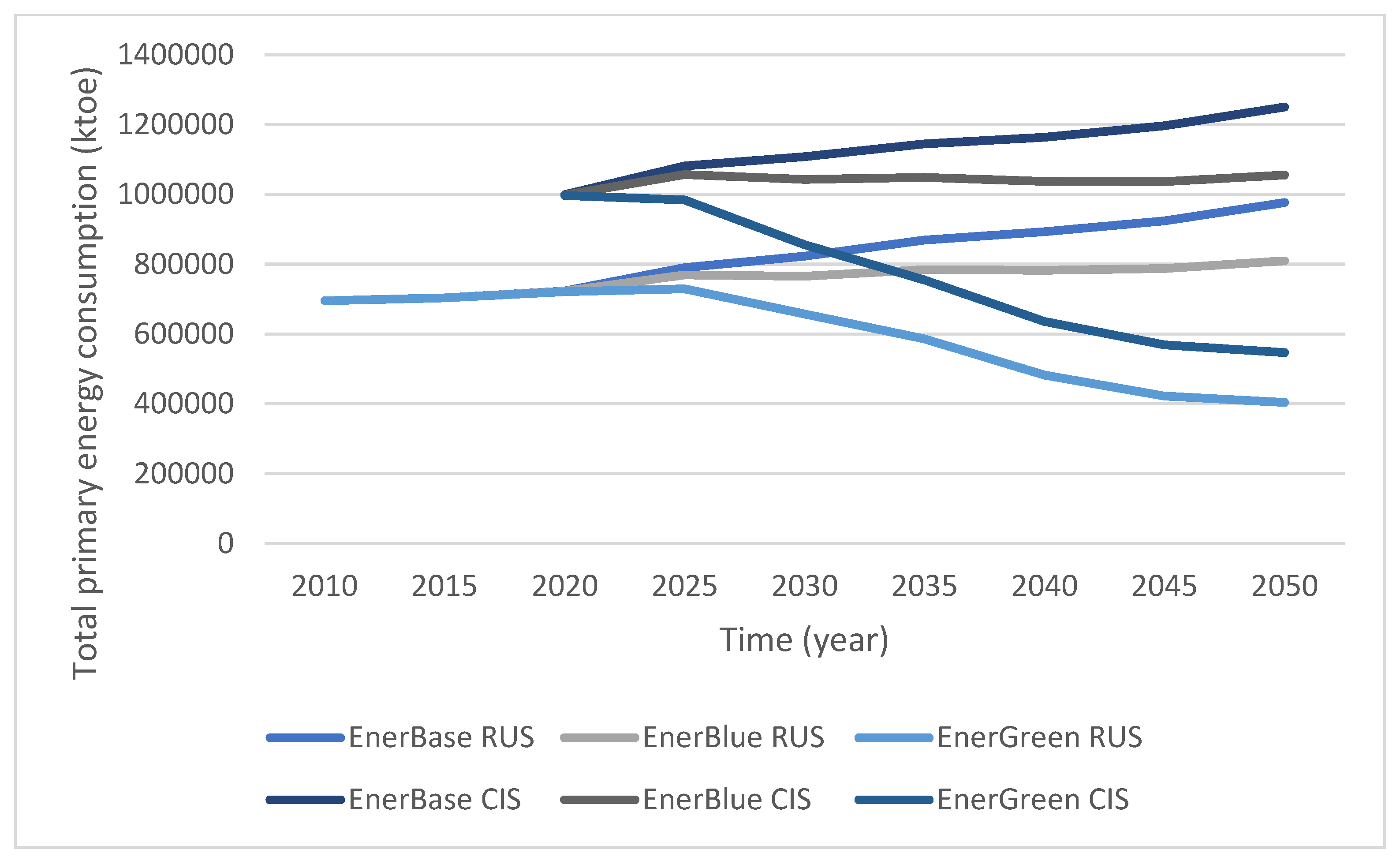
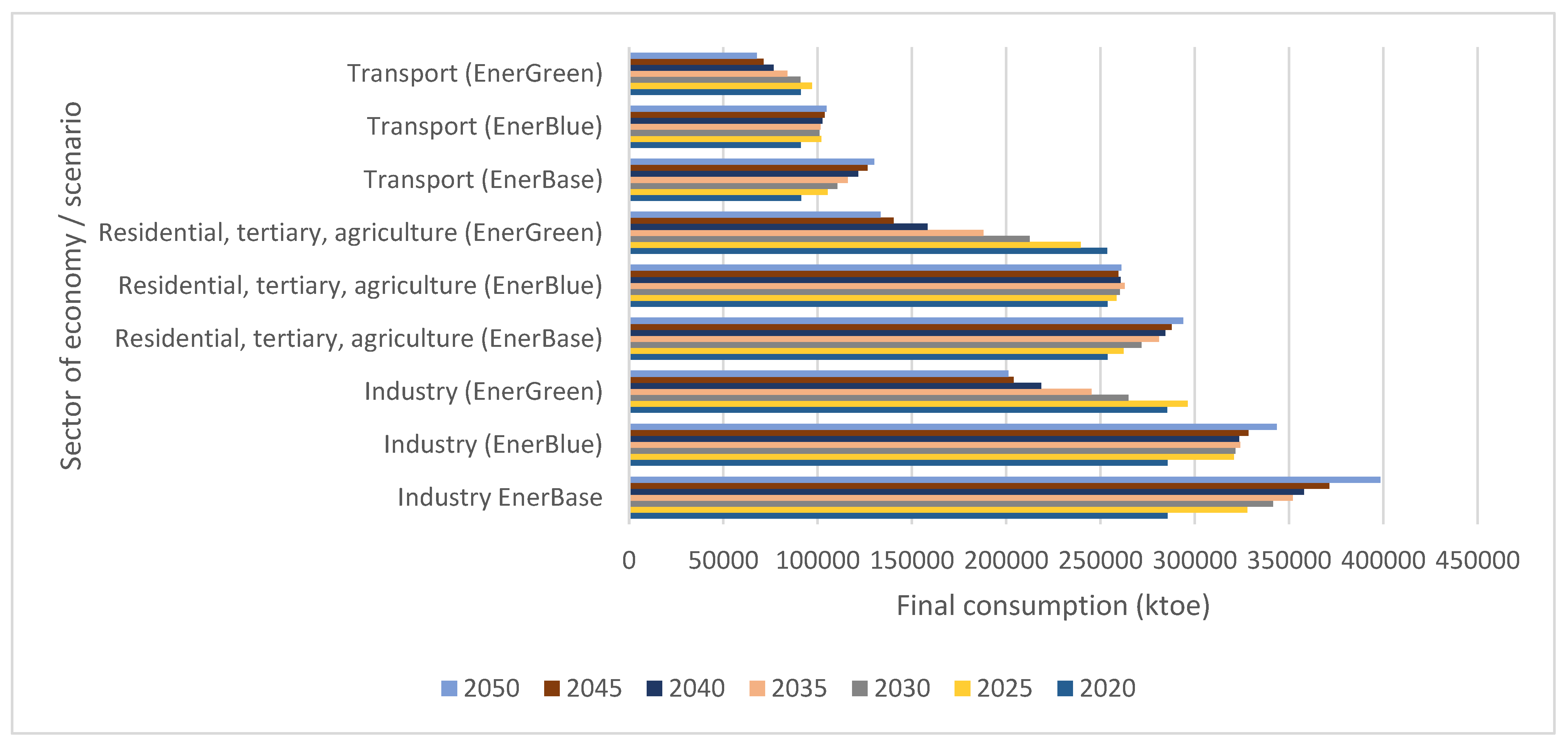
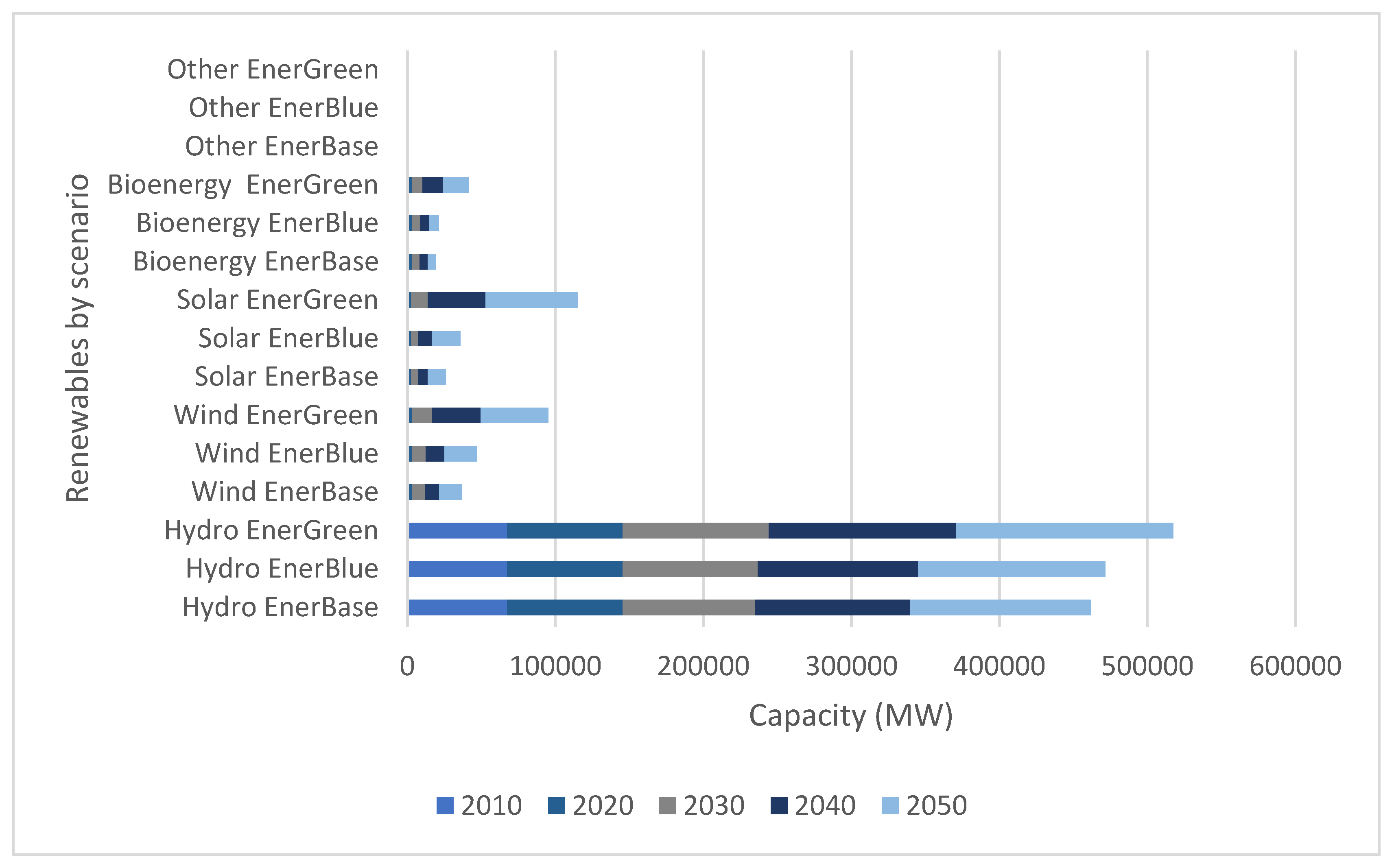
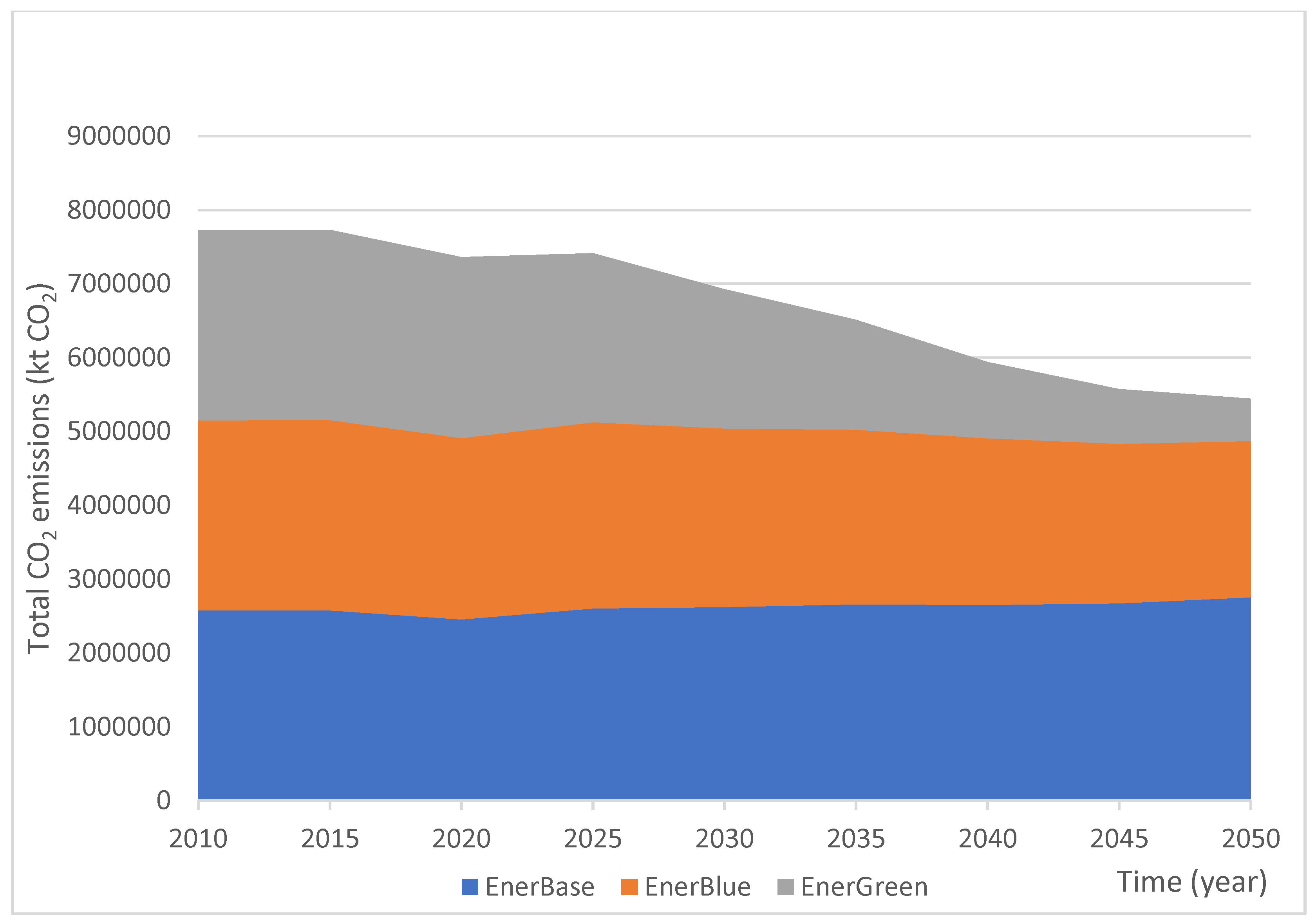
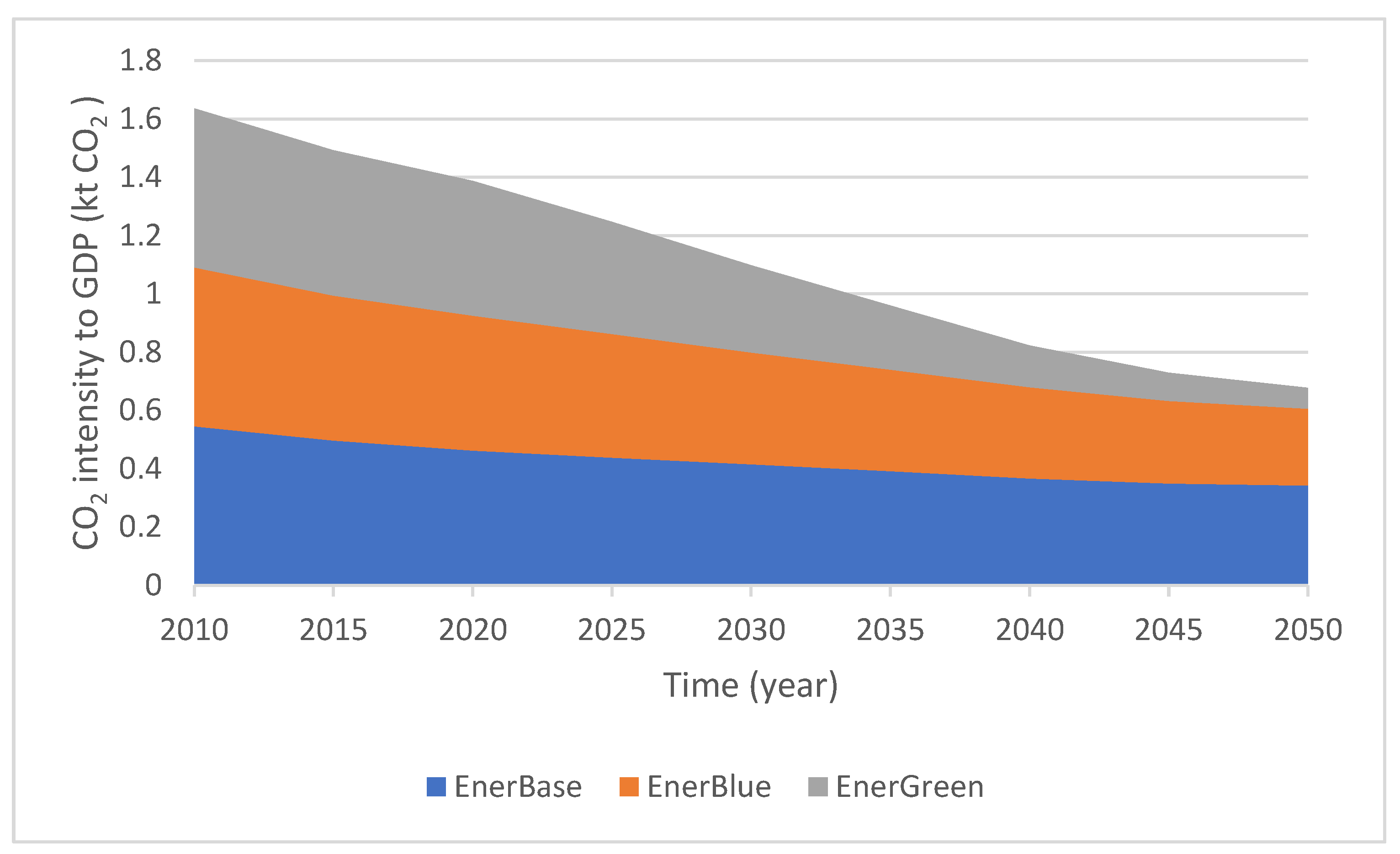
| EnerBase | EnerBlue | EnerGreen | |
|---|---|---|---|
| Climate and energy policies | Policies and efforts to mitigate GHG emissions are not compatible with Nationally Determined Contribution (NDC) targets | Policies and efforts to mitigate GHG emissions are compatible with NDC objectives | Policies and efforts to mitigate GHG emissions (including NDCs) are in line with Paris Agreement goals |
| Energy demand | High demand growth and modest improvements in energy efficiency | Moderate demand growth is compensated by energy efficiency | Significant energy efficiency improvements coupled with the absence of energy demand growth |
| Energy supply and prices | Fossil fuels dominate the energy mix and their prices increase, modest renewable additions occur | The share of fossil fuel is slowly decreasing and their prices slowly increase, substantial renewable additions occur | The share of fossil fuel sharply decreases and their prices drop, substantial renewable additions occur |
| Carbon intensity *, 2019–2050 | −1.9% | −2.9% | −7.0% |
| Energy intensity of GDP ** (final) | −1.4% | −1.9% | −3.3% |
| The CIS Member-States | Intended Nationally Determined Contributions (INDC), 2021 |
|---|---|
| The Republic of Armenia | By 2030 40% emission reduction from 1990 level. The country will keep its 2050 GHG mitigation—2.07 tCO2eq/capita that was integrated in its Long-Term Low Emission Development Strategy (LT-LEDS). The new 2030 mitigation target is 40% reduction below the 1990 level.) |
| The Republic of Azerbaijan | By 2030 the Republic of Azerbaijan aims at 35% GHG emission reduction compared to 1990 level. |
| The Republic of Belarus | By 2030 the Republic of Belarus committed to reduce GHG emissions by at least 28% compared to the 1990 level, excluding the Land Use, Land-Use Change, and Forestry sector, and without any additional conditions. |
| the Republic of Kazakhstan | By 2030 a 15% reduction in GHG emissions compared to the base year.By 2030 a 25% reduction in GHG emissions compared to the base year, on the condition of international investments, access to green climate funds, low carbon technology transfer, and flexible mechanism for economy in transition. |
| The Kyrgyz Republic | Unconditional reduction of GHG emissions by 16.63% by 2025 and by 15.97% by 2030. Should additional international support be rendered, the reductin will make up 36.61% by 2025 and 43.62% by 2030. |
| The Republic of Moldova | By 2030 the Republic of Moldova is committed to an unconditional 70% net GHG emissions reduction target as compared to 1990 level. The previous commitment in NDC1 was 64–67%. The reduction target could be increased to 88% compared to 1990 level should access to low-interest financing, technology transfer and technical cooperation be assured. |
| The Russian Federation | By 2030 the Russian Federation aims at 70% GHG reduction compared to the 1990 level, consideraing the maximum absorptive capacity of ecosystems (primarily forests) and not t the detriment of the sustainable social and economic development in the country. |
| The Republic of Tajikistan | By 2030 the GHG emission reduction in Tajikistan will not exceed 60–70% of the 1990 emission level. Should international funding and technology transfer be provided the reduction will not exceed 50–60% of the 1990 emission level. |
| Turkmenistan | By 2030 should financial and technology support be provided, Turkmenistan could achieve zero emission icrease and may even achieve a reduction. |
| The Republic of Uzbekistan | By 2030 the Republic of Uzbekistan has increased its commitments and intends to reduce specific GHG emissions per unit of GDP by 35% compared with the 2010 level (in the NDC1 a 10% reduction was specified). |
Publisher’s Note: MDPI stays neutral with regard to jurisdictional claims in published maps and institutional affiliations. |
© 2022 by the authors. Licensee MDPI, Basel, Switzerland. This article is an open access article distributed under the terms and conditions of the Creative Commons Attribution (CC BY) license (https://creativecommons.org/licenses/by/4.0/).
Share and Cite
Proskuryakova, L.; Ermolenko, G. Decarbonization Prospects in the Commonwealth of Independent States. Energies 2022, 15, 1987. https://doi.org/10.3390/en15061987
Proskuryakova L, Ermolenko G. Decarbonization Prospects in the Commonwealth of Independent States. Energies. 2022; 15(6):1987. https://doi.org/10.3390/en15061987
Chicago/Turabian StyleProskuryakova, Liliana, and Georgy Ermolenko. 2022. "Decarbonization Prospects in the Commonwealth of Independent States" Energies 15, no. 6: 1987. https://doi.org/10.3390/en15061987
APA StyleProskuryakova, L., & Ermolenko, G. (2022). Decarbonization Prospects in the Commonwealth of Independent States. Energies, 15(6), 1987. https://doi.org/10.3390/en15061987






